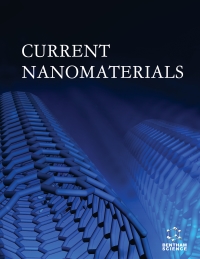- Home
- A-Z Publications
- Current Nanomaterials
- Previous Issues
- Volume 9, Issue 3, 2024
Current Nanomaterials - Volume 9, Issue 3, 2024
Volume 9, Issue 3, 2024
-
-
Silver Nanoparticulate Carriers: A Significant Development in Nanotechnology
More LessAuthors: Boga V. Kumar, Gyati Shilakari Asthana, Abhay Asthana and Rakesh GaddamBackground: For centuries, silver has been known for its anti-bacterial effects. It also helps in the prevention and control of various infections. Silver, when synthesized in nano-size, is much more effective, so the trend of using silver nanoparticles in treating mild bacterial diseases to deadly infectious diseases has increased rapidly. Methods: Silver nanoparticles can be synthesized by physical, chemical, and biological method Read More
-
-
-
Miniaturization of Nucleic Acid Assemblies in Nanodevice: Nano-Oddities
More LessIn the past decades, it has been evident that nano miniaturization technology plays a vital role in innovations, biomedical and industrial applications. Most importantly, the use of Lab on chip (LOC) is revolutionizing and highly replacing the use of conventional technologies due to its advantages that include reliability, biocompatibility, tunability, portability, controllability, cost-effective, low time, and energy consumption with more Read More
-
-
-
A Review on Nanosponges: An Idiosyncratic Approach for Delivery of Proactive Molecules
More LessAuthors: Meenakshi Attri, Asha Raghav, Komal Rao, Parijat Pandey and Neha MinochaBackground: A lot of work has been done by many researchers to develop a system that is targeted at a specific site. Nanosponges are one of the systems that serve this purpose and have several advantages over other methods. Objective: The article’s strategy is to provide access to data regarding the nanosponges system, including its preparation, evaluation, and advantages in various fields, such as the transportation of Read More
-
-
-
Intranasal Delivery of Lipid Nanoparticles: A Ground-breaking Approach for Brain Targeting
More LessAuthors: Devashish Jena, Nimisha Srivastava, Mohd Yasir and Deblina DanIn the present scenario, various novel delivery systems are available for drug delivery to systemic circulation. So, to accomplish a greater therapeutic effect, the nature of the drug delivery is very important. This delivery is one of the innovative approaches where the drug is targeted to the brain through the nasal cavity. As we know, the human brain is the most crucial part of the body that controls various functions of ou Read More
-
-
-
The Copper Metal and Magnetite Nanoparticles Conjugated with Salicylic Acid Composite Stimulated Wheat Defense Mechanism and Affected Cellular Components under Heat Stress
More LessAuthors: Taher A. Salaheldin, Asmaa A. Mahdi, Mohamed H. Hendawey and Nahla S. HassanAims: This study aimed to examine the effect of magnetite coating of salicylic acid and Cu metal nanoparticles on yield, cellular contents, and some biochemical constituents of wheat subjected to heat stress. Background: An applied experiment was conducted over two seasons at the Agricultural Experimental Station of Desert Research Center (DRC), which was supervised by the El Wadi El Gadeed Governorate in Egypt. The grains Read More
-
-
-
Green Capping Agents and Digestive Ripening for Size Control of Magnetite for Magnetic Fluid Hyperthermia
More LessAuthors: Heba Kahil, Ismail Abd El-Rahim Ali and Hadir EbraheemBackground: Magnetite is the most recognized iron oxide candidate used for various biological applications. Objective: This work is a complete study that addresses the synthesis of magnetic nanoparticles and investigates the feasibility of using green tea and ascorbic acid as capping agents. Methods: Synthesis of magnetite by two wet chemical methods namely: coprecipitation and solvothermal methods. The samples Read More
-
-
-
Formulation Design and Characterization of Nilotinib Polymeric Nanoparticles by Nanoprecipitation Technique for the Improved Drug Solubility and Dissolution Rate
More LessAuthors: Mallika Tamminana and Bera V. V. Ravi KumarIntroduction: Nilotinib is a BCS class-IV poorly water-soluble kinase inhibitor drug, that was used for this study to prepare the polymeric nanoparticles by nanoprecipitation technique using Eudragit RL-100 and RS-100 as polymers, Killophore P-188 as a surfactant, and PEG 400 used as a non-volatile, and nontoxic solvent for the improvement of the drug solubility and dissolution rate. Methods: The initial process and for Read More
-
-
-
Investigation of Corrosion Protection Through CNTs/ CNFs Modified Cement Mortars
More LessBackground: the performance of nano modified cement based materials is substantial in terms of their mechanical durability and other similar properties that are of great importance in the functional life of cement structures. The motivation of this study is to formulate conclusions concerning the anti-corrosive impact of Carbon nanotubes (CNTs) and Carbon nanofibers (CNFs) on the properties of mortar specimens Read More
-
-
-
Thin Ga-doped ZnO Film with Enhanced Dual Visible Lines Emission
More LessAuthors: Sanaz Alamdari, Mohammad Mansourian and Morteza S. GhamsariIntroduction: In this study, a simple and facile route was employed to prepare a highly transparent and luminescent ultra-thin gallium doped ZnO film (GZO). Methods: The thin GZO film has been deposited using the simultaneously ultrasonic vibration and sol-gel spin-spray coating technique. The structural and optical properties of pure and doped thin films were investigated by various methods, such as X-ray diffraction (XRD), Read More
-
Most Read This Month
Article
content/journals/cnm
Journal
10
5
false
en


